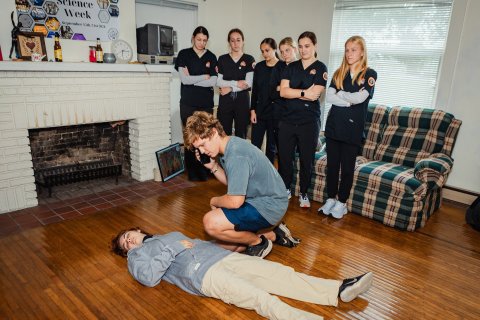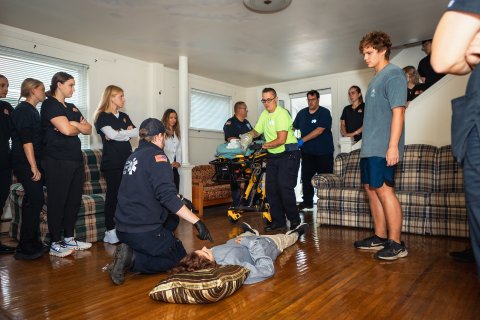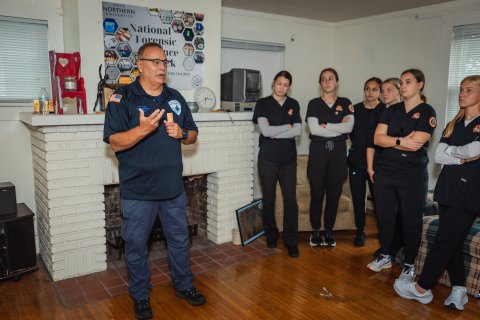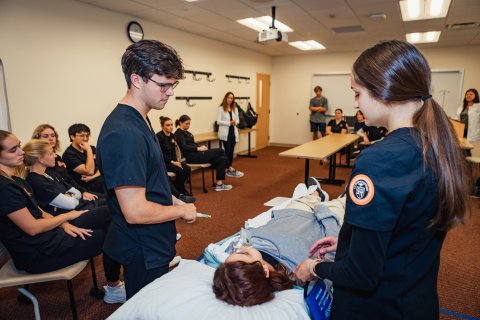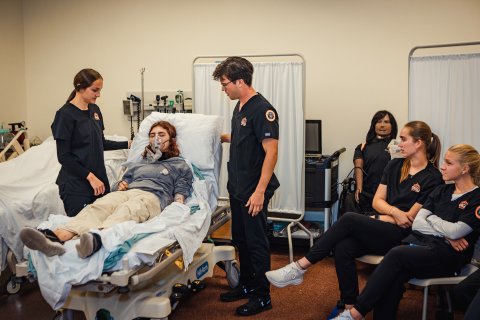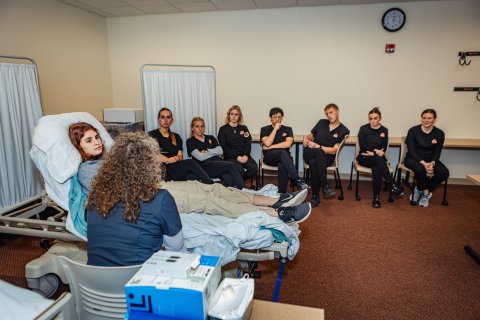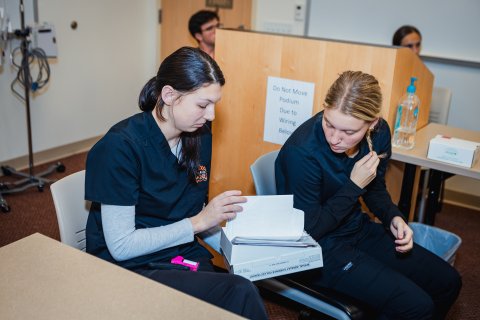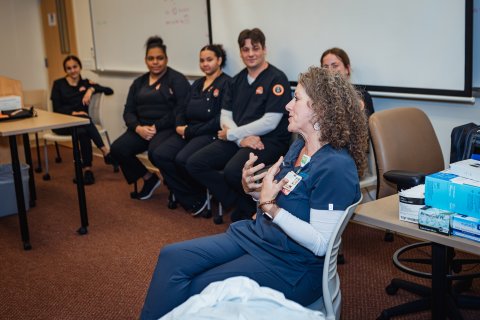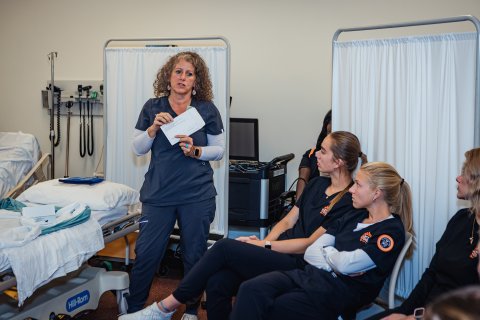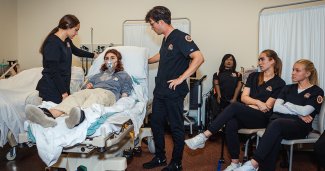
Ohio Northern University’s nursing program seeks to produce nurses who are effective caregivers and problem-solvers in the face of any challenge.
To that end, every fall semester the program collaborates with the broader community to stage a simulation of a drug overdose/potential sexual assault case for its senior nursing students.
If a scenario is unsettling or even shocking, it’s all the more reason to first encounter it in a safe learning environment versus under pressure while on the job, said Megan Lieb, associate professor of nursing.
“Our goal is to give our students a lot of different experiences in the tool kit to draw upon,” she explained.
An ONU theatre student, Ada-Liberty Township paramedics, and forensic nurse and ONU alumna Michelle Yeasting, BSN ’17, each play a role in an impactful simulation that teaches students about the roles of paramedics and forensic nurses in the healthcare system, as well as best practices for caring for patients who may also be victims of sexual assault, trafficking, or physical abuse.
“Understanding trauma-informed language and the do’s and don’ts of treatment and care in these types of real world situations is vital for every well-trained nurse,” said Leib.
See the simulation play out in pictures and words.
Emergency at the Crime Scene House
Nursing students arrive at ONU’s Crime Scene house where a young woman appears unconscious on the floor seemingly from a drug overdose. Using real people—typically ONU theatre students—to playact the roles adds to the simulation’s sense of reality. The “roommate” returns home, tries to revive his friend, and frantically dials 911 while hiding the drug paraphernalia that’s scattered around the room.
“It’s uncomfortable for the nursing students to watch this scene unfold. But when students are outside their comfort zones, they are ready to engage in a high level of learning,” said Lieb.
Ada EMS arrives
Ada-Liberty EMS personnel arrive on the scene, assess the “patient” and pretend to administer Narcan and other life-saving measures. They load the victim onto the stretcher and into the ambulance for transport.
“Our goal is always to get them breathing, get their heart beating again, and get them transported to the hospital as soon as we can,” Ada EMS Chief Tom Miller explained to the students.
EMS chief shares knowledge
Once the “patient” departs, Miller spends about 30 minutes sharing his knowledge and answering questions. Students learn how paramedics treat different types of drug overdose cases, including details on the use of Narcan for opioid overdoses. They also learn about the range of capabilities of paramedics on the scene, the care delivered inside ambulances, and the handoff of patients to ER staff.
“I found it interesting how paramedics have a broad scope of practice including intubating and administering medications without a doctors’ orders,” said Joey Kennedy, ONU senior nursing student.
Students assess the “patient”
The “patient” arrives at the “hospital,” which is actually an ONU nursing lab. Paramedics handoff the “patient” to two ONU nursing students who volunteered to participate in the simulation.
“We do a lot of simulations with mannequins, which are helpful, but actually getting to communicate with this patient was a great experience,” said Olivia Altiere, ONU nursing student.
Students learn how to interact with vulnerable patients
After making sure the “patient” is stable, the two nursing students attempt to question her to find out more about her and what might have transpired in the course of her evening. They make the determination to call in the forensic nurse after discovering that a sexual assault may have occurred.
“The simulation gave us a great opportunity to learn about Emergency Department interactions, and how sometimes the nurse may forget important things when their adrenaline is up. The important questions are the five W’s (who, what, where when, why) after stabilization because the nurse is trying to gather a history of the incident,” said Joey Kennedy, ONU nursing student.
Encountering trauma-informed care and language
Michelle Yeasting, BSN, RN, SANE-A, SANE-P, who founded and heads the forensic nursing program at Blanchard Valley Hospital in Findlay, demonstrates the importance of trauma-informed language in interacting with patients who may have been victimized.
“You should always ask the person if they feel safe and keep in mind that safe doesn’t always mean the same thing to everyone. Ask them questions like ‘are you OK to go home’ and ‘do you want this person in the room?’”
Learning about forensic nursing
Yeasting explains the invaluable role of forensic nurses in the healthcare system. Forensic nurses not only deliver vital care to patients, but also document and collect evidence that may later be used in a court of law to bring perpetrators to justice. Sometimes, forensic nurses even testify in court. Yeasting shows the students a rape kit and explains how evidence is collected, she also explains the prophylaxis care given to rape victims.
“Forensic nursing bridges the gap between the medical and legal system.”
Giving power back to the victim
Dealing with victims of sexual abuse sometimes requires nurses to put aside their own sense of what’s right. It’s important to give the victims the time and space to process what happened and decide the course forward, advised Yeasting.
“Nursing ethics is that we want to do good and promote good, and sometimes that conflicts with patient autonomy. What happened to them belongs to them and it’s their timing when they want to talk about it. Give the patients back the power to make that decision, because so much has been taken from them already.”
Final Q&A
Yeasting shares stories and knowledge from her years of experiences in forensic nursing. At the end, she engages in a collaborative Q&A with the students. Students then take the rest of the day to decompress, and later complete a Post-Simulation Opioid Overdose Attitudes Scale developed by Williams, Strang, and Marsden (2013) as well as respond to a series of reflective questions.
“My biggest takeaway was to never assume anything, or try to make a decision for a patient that you feel is right for them. At the end of the day, people have autonomy to make decisions on their own, and they are responsible for those decisions. Another big takeaway is the crucial role of a forensic nurse because they have been trained in the proper communication style and the keys to look at when assessing a patient,” said Joey Kennedy, ONU nursing student.
